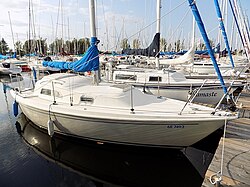Engineering:Pearson 26
 | |
| Development | |
|---|---|
| Designer | William Shaw |
| Location | United States |
| Year | 1970 |
| No. built | 1,750 |
| Builder(s) | Pearson Yachts |
| Boat | |
| Boat weight | 5,400 lb (2,449 kg) |
| Draft | 4.00 ft (1.22 m) |
| Hull | |
| Type | Monohull |
| Construction | Fiberglass |
| LOA | 26.17 ft (7.98 m) |
| LWL | 21.67 ft (6.61 m) |
| Beam | 8.67 ft (2.64 m) |
| Engine type | Outboard motor |
| Hull appendages | |
| Keel/board type | swept fin keel |
| Ballast | 2,200 lb (998 kg) |
| Rudder(s) | internally-mounted spade-type rudder |
| Rig | |
| Rig type | Bermuda rig |
| I (foretriangle height) | 31.50 ft (9.60 m) |
| J (foretriangle base) | 11.70 ft (3.57 m) |
| P (mainsail luff) | 27.50 ft (8.38 m) (the exact P dimension is disputed) |
| E (mainsail foot) | 10.00 ft (3.05 m) |
| Sails | |
| Sailplan | Masthead sloop |
| Mainsail area | 137.50 sq ft (12.774 m2) |
| Jib/genoa area | 184.28 sq ft (17.120 m2) |
| Total sail area | 321.78 sq ft (29.894 m2) |
| Racing | |
| PHRF | 210 (average) |
The Pearson 26 is a family of United States sailboats, that was designed by William Shaw and first built in 1970.[1][2][3]
Production
The design was built by Pearson Yachts in the United States starting in 1970 and ending in 1983. The Pearson 28 was one of the company's most successful designs. A total of 1,750 of the base design were built, plus 300 of the Daysailor/Weekender and One-Design variants, for a total of 2,050 examples built.[1][3][4][5][6]
Design
The Pearson 26 family of designs are all a small recreational keelboats, built predominantly of fiberglass with balsa-cored decks and with wood trim. They all have a masthead sloop rig, raked stem, vertical transom, an internally-mounted spade-type rudder controlled by a tiller and a fixed swept fin keel. All versions have a length overall of 26.17 ft (8.0 m) and a waterline length of 21.67 ft (6.6 m), with hull speed of 6.24 kn (11.56 km/h).[1]
The boats all have a draft of 4.00 ft (1.22 m) with the standard keel fitted. The design is equipped with a transom well to mount a small outboard motor for docking and maneuvering. The outboard's fuel tank is mounted in a dedicated locker.[1][3]
Accommodations include a double "V"-berth in the forepeak, with a double folding door. A translucent hatch over the berth provides lights and ventilation. A main cabin dinette table converts to a double berth and there is also a settee berth, for a total of sleeping space for five people. The galley is arranged on both sides of the cabin, with the sink on the port side and optional stove on the starboard. A cooler can be mounted under the companionway ladder. The optional head is mounted on the port side.[3]
Other features include an anchor locker, two winches for the jibsheets, four fixed portlights and an adjustable backstay, plus genoa tracks.[3]
Variants
- Pearson 26
- This model was introduced in 1970 and produced until 1983, with 1,750 built. It displaces 5,400 lb (2,449 kg) and carries 2,200 lb (998 kg) of iron ballast. The fresh water tank has a capacity of 22 U.S. gallons (83 L; 18 imp gal). The boat has a PHRF racing average handicap of 210 with a high of 213 and low of 210.[1][7]
- Pearson 26W or Weekender and Daysailor
- This model was introduced in 1975, built until 1983 and has a longer cockpit and shorter coach house. It has the same rigging as the 26, but lighter displacement. It displaces 5,200 lb (2,359 kg) and carries 2,200 lb (998 kg) of ballast. The boat has a PHRF racing average handicap of 213 with a high of 219 and low of 210.[5][8]
- Pearson 26 One-Design
- This model was introduced in 1978, built until 1983 and is a variant of the "W" version for one-design racing. It displaces 5,200 lb (2,359 kg) and carries 2,200 lb (998 kg) of ballast.[6]
Operational history
John Kretschmer of Sailing magazine reviewed the Pearson 26 in detail in August 2001, in a used boat review, as the design had been out of production for 18 years at the time. He noted "The Pearson 26 has a roomy, relatively comfortable cockpit for three or four adults...the Weekender and One-Design have slightly larger cockpits. All boats came with tiller steering, although I am sure somewhere in the world there is a 26 retrofitted with wheel steering...There is not much of a bridgedeck-basically just a sill-but this is not a boat intended for offshore sailing. The cockpit seats are low and visibility from the helm over the deckhouse is not great, especially if you're short. The tradeoff is more room below and a drier boat...Few people buy the Pearson 26 for its spacious accommodations below. However, the interior plan is well-thought-out, and the boat has more room than you might think. Dropping below, the first thing you'll notice is the headroom, about 5 feet, 10 inches by my estimate...The P26 needs a headsail, since performance is marginal under main alone, and a large 130- to 150-percent genoa can be carried upwind with a full main in winds to about 15 knots. At that point shortening up the headsail flattens the boat and keeps the speed up. Most owners tie a reef in the main as the apparent wind inches toward 20 knots. The P26 handles well off the wind, and several owners describe surfing downwind at near double-digit speeds...The Pearson 26 is an ideal boat to test the waters, so to speak, to see if sailing is indeed something you might enjoy. If you find you can't get enough time on the water, the P26 is not a boat you will quickly outgrow. It pleases on a variety of levels.[9]
See also
Related development
Similar sailboats
- Beneteau First 26
- Beneteau First 265
- C&C 26
- C&C 26 Wave
- Contessa 26
- Dawson 26
- Discovery 7.9
- Grampian 26
- Herreshoff H-26
- Hunter 26
- Hunter 26.5
- Hunter 260
- Hunter 270
- MacGregor 26
- Mirage 26
- Nash 26
- Nonsuch 26
- Outlaw 26
- Paceship PY 26
- Parker Dawson 26
- Sandstream 26
- Tanzer 26
- Yamaha 26
References
- ↑ 1.0 1.1 1.2 1.3 1.4 Browning, Randy (2018). "Pearson 26 sailboat specifications and details". sailboatdata.com. https://sailboatdata.com/sailboat/pearson-26. Retrieved 25 August 2018.
- ↑ Browning, Randy (2018). "William Shaw". sailboatdata.com. https://sailboatdata.com/designer/shaw-william. Retrieved 25 August 2018.
- ↑ 3.0 3.1 3.2 3.3 3.4 Sherwood, Richard M.: A Field Guide to Sailboats of North America, Second Edition, pages 176-177. Houghton Mifflin Company, 1994. ISBN:0-395-65239-1
- ↑ Browning, Randy (2018). "Pearson Yachts". sailboatdata.com. https://sailboatdata.com/builder/pearson-yachts. Retrieved 25 August 2018.
- ↑ 5.0 5.1 Browning, Randy (2018). "Pearson 26 Weekender sailboat specifications and details". sailboatdata.com. https://sailboatdata.com/sailboat/pearson-26-weekender. Retrieved 25 August 2018.
- ↑ 6.0 6.1 Browning, Randy (2018). "Pearson 26 (One-Design) sailboat specifications and details". sailboatdata.com. https://sailboatdata.com/sailboat/pearson-26-one-design. Retrieved 25 August 2018.
- ↑ InterVisionSoft LLC (2018). "Sailboat Specifications for Pearson 26". Sailing Joy. http://www.sailingjoy.com/sailboat_specs/sailboat_specs/view/552/pearson-26. Retrieved 25 August 2018.
- ↑ InterVisionSoft LLC (2018). "Sailboat Specifications for Pearson 26W". Sailing Joy. http://www.sailingjoy.com/sailboat_specs/sailboat_specs/view/4372/pearson-26w. Retrieved 25 August 2018.
- ↑ Kretschmer, John (August 2001). "Used Boat Notebook - Pearson 26". Sailing magazine. http://sailingmagazine.net/article-552-pearson-26.html.
External links
 |




